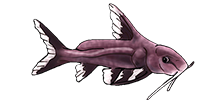EDIT: Until they can be considered for a new L-number or get a proper identification to a known fish, these are now cataloged as .
Today I found three unusual Chaetostoma mixed in with a shipment sold as . Some fish in the tank were C. formosae for sure, plus there were several of its most common contaminant, . But then there were also these three fish. Their their body shape and color were instantaneously distinctive:
As for body shape, these three fish were more elongate and thin (not thin as in emaciated, but thin as in body proportion) in the body compared to both C. formosae and C. dorsale in the tank with them.
As for body colors:
- Body is a tan base color with a dark slate gray coloring over it.
- The tan base color stands out because these fish were in a tank with and , the former having an olive base color and the latter having a dark slate gray base color.
- The head has a darker slate gray base color with light tan spots. The tan spots on the head are small, densely-packed, and irregular in shape. They remind me of mosaic color tiles in artwork, or the pieces of a jigsaw puzzle.
- On the dorsal lip of the largest individual, the tan mosaic spots are much larger (3-4x larger) than on the head and are separated by greater distances of the dark gray color.
- On the smaller specimens, the spots on the dorsal lip are more uniform in size relative to other head spots.
- The armor plates have pale gray diagonal lines (oriented from anterio-dorsal to posterio-ventral) along the crests of the armor plates. Most of the lines are broken near the midline of the body.
- All three fish showed five prominent saddles (in the tan base color, not the light gray color of the stripes). The most anterior saddle was located at the base of the dorsal fin spine, and the most posterior was at the end of the caudal peduncle, immediately before the tail. I presume the saddles are exaggerated in stress coloration, but I will wait to see if the saddles fade when the fish adapt to my tank.
- The combination of pale gray lines and tan saddles creates an irregular camouflage pattern which is not easy to describe. In some ways, it reminds me of the random camouflage of .
- Dorsal, pectoral, pelvic and caudal fins are banded, at least along their fin rays. The membranes on the dorsal, pectoral, pelvic fins are hyaline/transparent. The caudal fin is more strongly banded on its rays, but I believe the caudal fin membrane is hyaline also (but the fish did not want to expand their caudal fins for me, so I cannot confirm this).
- These fish show little or no iridescence. When I used a flash with my camera, there was a hint of gold iridescence on the face (where the tan spots are). But otherwise, none. Although these three fish share some similarity to C. dorsale, the latter species has very strong iridescence when photographed with flash cameras.
I will try to track down the source and get more information on these (and more fish too). Do we have a new L number here?
Cheers, Eric





/g/s/1.jpg)





/g/s/1.jpg)












